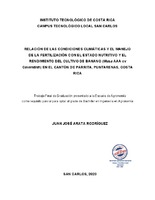Relación de las condiciones climáticas y el manejo de la fertilización con el estado nutritivo y el rendimiento del cultivo de banano (Musa AAA cv Cavendish) en el cantón de Parrita, Puntarenas, Costa Rica
Abstract
El trabajo se realizó en la empresa Frutas Selectas del Trópico S.A, ubicada
en la comunidad de Parrita, en el Pacífico central de Costa Rica, con el propósito
de analizar la relación de las condiciones climáticas y el manejo de la fertilización
con el estado nutritivo y el rendimiento de producción del cultivo de banano (Musa
AAA cv Cavendish) en las dos fincas de la empresa, La Flor y San Gerardo. Se
realizó un análisis descriptivo de los datos de fertilización de las fincas, desde
mayo 2017 hasta mayo 2019, generando reportes de dosis de cada fuente
utilizada, dosis de cada nutrimento aplicado al cultivo, momento de aplicación,
niveles foliares de los nutrimentos y la productividad de las fincas. Además, se
generaron gráficos de los datos climáticos de la zona, realizando análisis de
correlación entre los datos climáticos y los contenidos foliares de los nutrientes y la
productividad de las fincas.
Tanto las dosis aplicadas de cada nutrimento como la concentración foliar de
N, P, Ca, Mg y S coincidieron con lo reportado en la literatura. La concentración
foliar de K estuvo por debajo de los niveles óptimos (3,6% - 4,0%) según Sánchez
(2017) en las dos fincas con un promedio de 3,49% para La Flor y 3,54% para San
Gerardo, a pesar de que las cantidades aplicadas fueron las más altas
recomendadas en este cultivo. En el caso del Zinc el promedio de aplicación fue
de 3,2 kg y 2,9 kg de Zn/ha/año en las fincas La Flor y San Gerardo
respectivamente, lo que es superior a lo recomendado en la literatura y esto se
relacionó con contenidos foliares en ambas fincas sobre el nivel óptimo. El boro
se aplicó en promedio 0,4 kg/ha/año en las dos fincas evaluadas, lo que es inferior
a lo mencionado en la literatura (0.7 kg/ha/año), lo que se reflejó en la
concentración foliar por debajo de lo óptimo recomendado.
Se encontró correlación negativa entre la variable lluvia acumulada mensual y
la concentración de los nutrientes Ca, Mg, S y Zn en Finca La Flor (p-valor <0,01).
La correlación también fue negativa entre lluvia acumulada mensual y la
concentración de Ca y Mg en Finca San Gerardo (p-valor<0,05). The work was carried out at the company Frutas Selectas del Trópico S.A,
located in the Parrita community, in the central Pacific of Costa Rica. With the
purpose of analyzing the relationship of climatic conditions and the fertilization
management of the banana crop (Musa AAA cv Cavendish) with the nutritional
status and production yield in the two farms of the company, La Flor and San
Gerardo. A descriptive analysis of the fertilization data of the farms was carried
out, from May 2017 to May 2019, generating reports of the dose of each source
used, the dose of each nutrient applied to the crop, time of application, foliar levels
of the nutrients and productivity of the farms. In addition, graphs of the climatic
data of the area were generated, performing analysis of covariance between the
climatic data and the foliar contents of the nutrients and the productivity of the
farms.
The leaf levels of the main nutrients were within the optimal range according to
the literature, such as: N, P, Ca, Mg, S. The annual average of the leaf level of K
was below the optimum levels in the two farms, despite the fact that the applied
amounts are the highest recommended according to the literature. In the case of
Zinc, the average application was 3.2 kg and 2.9 kg of Zn / ha / year in the La Flor
and San Gerardo farms, respectively, which is higher than that recommended in
the literature and this was related to foliar contents on both farms above the
optimum level. The boron nutriment was applied on average 0.4 kg/ha/year in the
two farms evaluated, which is slightly less than what is mentioned in the literature
of 700 g/ha/year; reason why a foliar content of B was presented in the two farms
below the recommended optimum limit. Nutrients Ca, Mg, S and Zn have a highly
significant negative correlation with the variable accumulated rainfall and a
significant correlation was presented with rainfall and temperature, with the
productivity of the farms. The data obtained allows adjusting and correcting the
fertilization programs to improve the company's productivity and repeatability.
Description
Proyecto de Graduación (Bachiller en Ingeniería en Agronomía) Instituto Tecnológico de Costa Rica, Escuela de Ingeniería en Agronomía, 2020


